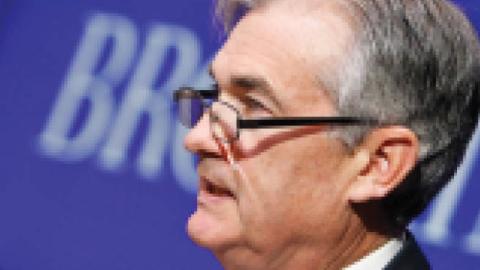The Fed Emperor’s New Clothes Show is a continuous comedy without laughter. The latest act, the virtual Jackson Hole conference (August 27), was dreadful.
The show's audiences are accustomed to the Fed chair and his board delivering solemn pronouncements about their aims—low inflation, high employment, and financial stability. These officials play their parts according to script. They never explain how they will fulfill their promise—it is all boast and no substance. The assembled courtiers, including the financial media representatives who form part of the Fed’s propaganda machine, never ask difficult questions. Those inclined toward skepticism fear exposing their own lack of knowledge or losing their jobs.
In the just finished Jackson Hole episode, Chief Powell revealed that the Fed is now to target an average 2 percent inflation over the medium and long run, meaning that it will “steer” inflation above that level as needed to compensate for periods when it has languished below. Yet in the contemporary monetary system without anchor, there is no high-powered money aggregate whose growth firmly sets boundaries to the long-run path of goods and services prices. Instead, the Fed seeks to achieve its target by employing the blunt and highly imprecise instruments of interest rate manipulation, while counting on inertia of inflation and inflation expectations. That is always a recipe for huge economic and financial instability.
The essence of the policy framework review, just unveiled by Chief Powell, is that the Fed will be slower than in recent cycles to adapt that blunt instrument to any incipient buildup of monetary inflation symptoms in goods and services markets. Accordingly, the danger of an inflation breakout at some point in the future has increased. An extended deep recession through the present pandemic and beyond would delay that point.
Speculation on this Fed policy adjustment has been rife for many months. Similar shifts are occurring abroad, notably in Europe and Japan. The reality, though, is that the army of PhD economists at the Fed has not made a discovery in econometric science which would now reliably link the path of manipulated interest rates to the price level over time.
In fact, Chief Powell announced that his economics staff have discarded at last one notorious component of their craft, the notorious Phillips curve (purporting to relate the level of unemployment to inflation) while putting nothing in its place. And the chief has joked about the r stars and u stars (neutral interest rate and natural unemployment rate estimates) which once featured so heavily in Fed econometrics, notably in the application of the notorious “Taylor rule.”
Many of us already are so disenchanted with the central bankers led by the Fed hegemon that we just ignore the daily, weekly, or monthly theatricals—unless we are trying to profit from the asset price fluctuations which these give rise to in the short run. We should not, though, in our nonattendance of these shows overlook the degradations that monetary decisions announced there are inflicting on ourselves, whether in terms of our personal freedoms or of our reasonable hopes of enjoying economic prosperity.
As regards liberty, this Jackson Hole policy review blasts another wide gap in the constitutional guardrails which are meant to guarantee the right of US citizens to enjoy sound money. Of course, those guardrails were damaged severely almost a century ago when the Supreme Court ultimately approved the Roosevelt administration’s monetary radicalism. But now we have the Federal Reserve expanding and enforcing its 2 percent inflation standard without any challenge in prospect, whether from Congress, to which the Fed is “answerable,” or from the courts.
As regards the threat to economic prosperity, consider the present unique historical situation of Fed-created asset and credit market frenzy in the midst of a vast supply shock induced by pandemic. The sequel could yet be steep further recession, notwithstanding some recent rebound in economic aggregates as governments lift lockdowns.
The combination of pandemic with the interest income famine created by Fed policy has proved remarkably fertile ground for two speculative narratives. The first is that “determined action” by the Fed (and foreign central banks), including huge asset market purchase programs financed by money-printing, has removed solvency risk; hence the vast demand for high-yield (risky) credit during this pandemic. The second relates to monopoly profits from accelerated digitalization. According to this narrative, these present or potential mega-profits will far outlive the pandemic.
All this speculative froth has added to the appearance of giant monetary stimulus.
The froth, however, could dissipate suddenly—well before the arrival of any postpandemic boom economy. The mother of all monetary stimuli could turn out to be worse than a dud—a catalyst to a slide into further recession just as the supply shock of pandemic recedes. The Fed’s efforts to avoid financial crisis during the height of the pandemic could yet precipitate a still bigger crisis.
No one can predict (in honesty) the dynamics of massive momentum trading into “pandemic stocks” and high-yield credit driven by highly dubious narratives of thirty years of high monopoly rents ahead or the Fed having extinguished insolvency risks. That depends on knowing when a round of investors deciding to take profits in these quasi Ponzi schemes finds there is no new layer of investors to sell to and the other potential buyers—shorts closing their position—have long since exited the field, in most cases terrified by losses to date.
We do know, however, that the collateral against huge amounts of credit is tied in value to expanses of malinvestment, whether in emerging markets, global supply chains, or the brick-and-mortar economy, including commercial real estate, travel, energy extraction. Feared and actual destruction of collateral value is what drives the dynamics of recession and depression and this will likely transcend the journey of the pandemic.
The economic damage of pandemic as witnessed to date does not spare us from further revelation of huge misallocation and waste in consequence of the great asset inflation from 2013–20. The supply shock has highlighted some areas of malinvestment (especially aircraft, travel, shopping centers) while camouflaging others (for example excessive digitalization). Banks and credit institutions, especially in Europe, are critically vulnerable to collapse in collateral values. Neither fantasy about big tech monopoly rents nor vaccines and drug therapies can wipe away accumulated malinvestment and related credit losses.
The emperor in the show, whether we take this as Chief Powell or ultimately the president in the White House who appointed him, is now promising the audience a return to the “prosperity of the pre-pandemic economy.” Whether this would have endured ostensibly much longer without the interruption of pandemic is dubious. But the prosperity which the big monopolists are now promising us, based on accelerated digitalization driven by the exigences of the pandemic, is surely a mirage. Meanwhile Chief Powell blatantly fails to reveal that the biggest beneficiary of his reformed inflation target will be big government, for whom his institution is now a mammoth tax collector, with emphasis at first on monetary repression tax, and later on inflation tax.
Read in MISES Wire


















